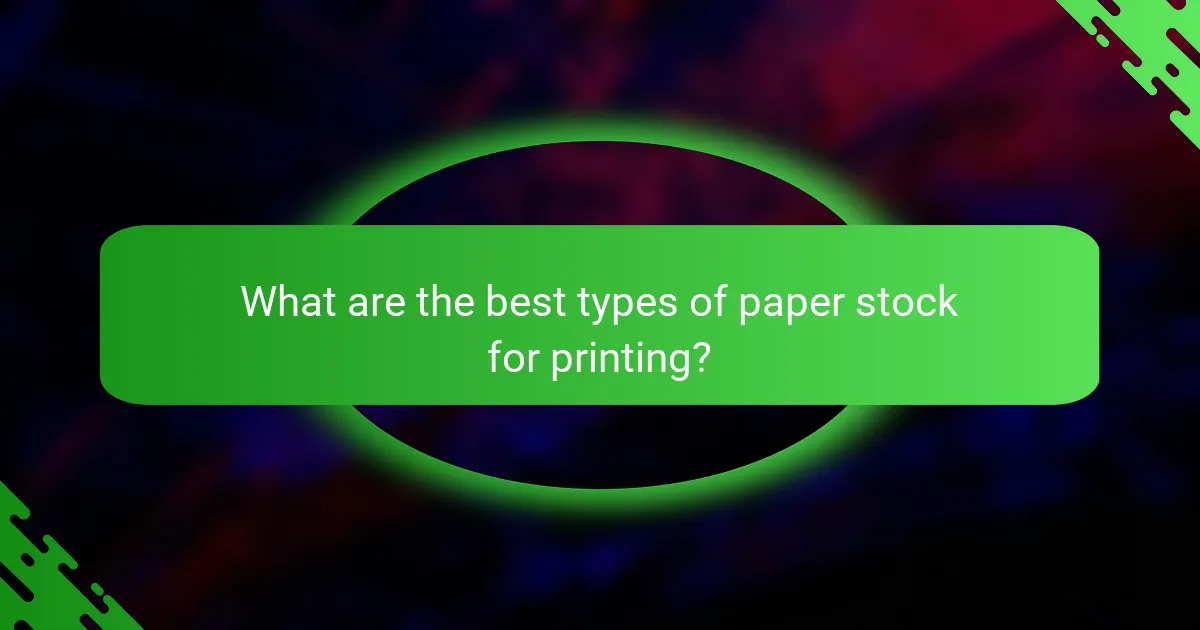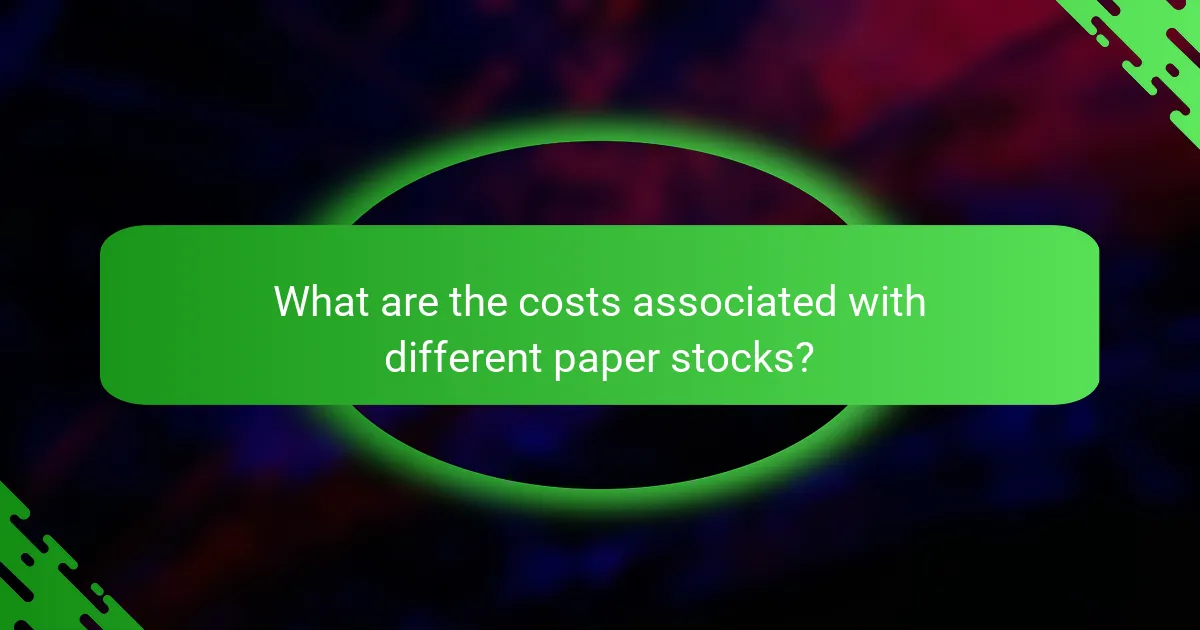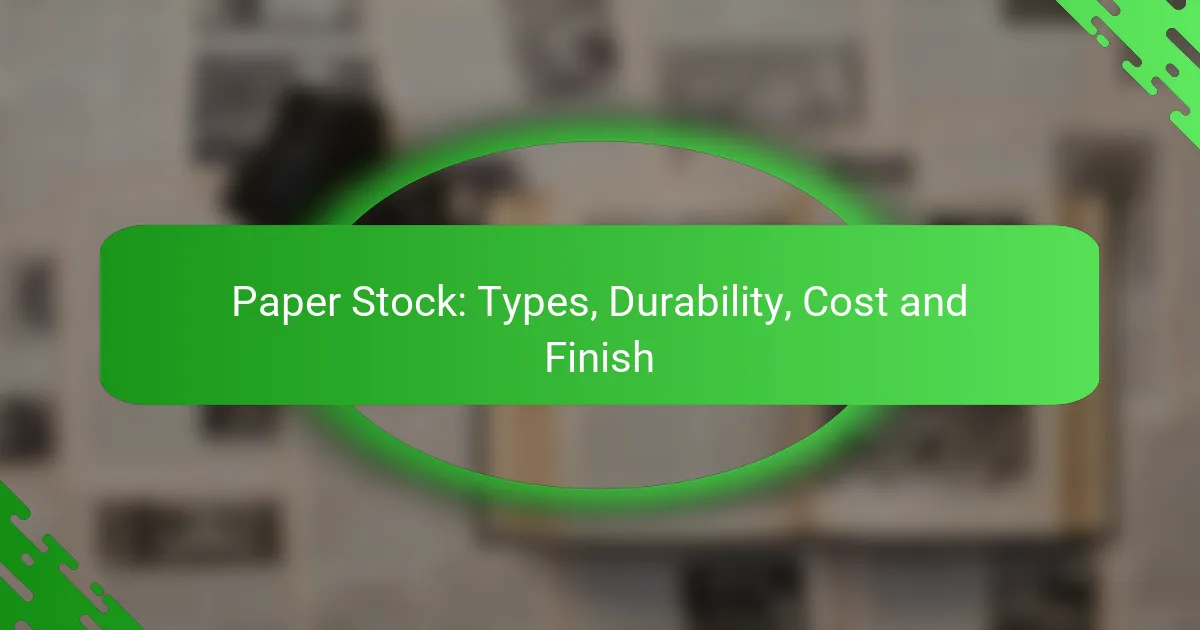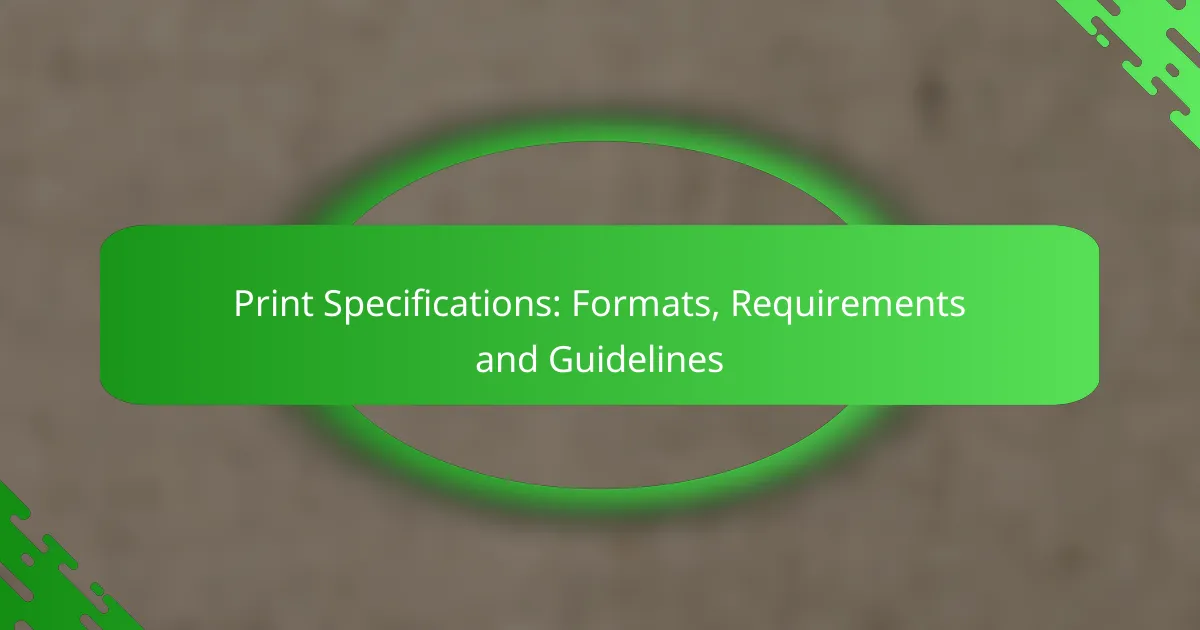Choosing the right paper stock is crucial for achieving the desired outcome in printing projects, as it affects durability, cost, and finish. Options range from sturdy cardstock to glossy and matte papers, each serving different purposes and aesthetic preferences. Understanding the characteristics and costs associated with various types of paper can help ensure that your printed materials meet both functional and visual standards.

What are the best types of paper stock for printing?
The best types of paper stock for printing depend on the intended use, desired durability, and finish. Common options include cardstock for sturdiness, text paper for everyday documents, glossy paper for high-quality images, and matte paper for a refined look.
Cardstock for durability
Cardstock is a thick, sturdy paper ideal for projects requiring durability, such as business cards, postcards, and invitations. It typically ranges from 200 to 350 gsm (grams per square meter), providing a solid feel that stands up to handling.
When choosing cardstock, consider the weight and finish. A heavier weight offers more durability, while finishes like coated or uncoated can affect the final appearance. For instance, coated cardstock is excellent for vibrant colors, while uncoated provides a more natural look.
Text paper for everyday use
Text paper is commonly used for everyday printing needs, such as letters, reports, and flyers. It generally ranges from 70 to 120 gsm, making it lightweight and easy to handle.
When selecting text paper, consider brightness and opacity. Higher brightness levels enhance color reproduction, while good opacity prevents ink bleed-through. Standard options include recycled paper for an eco-friendly choice and premium text paper for a more polished finish.
Glossy paper for vibrant images
Glossy paper is designed for printing high-quality images, making it ideal for photographs, brochures, and marketing materials. It features a shiny finish that enhances color saturation and detail.
When using glossy paper, be mindful of drying times, as ink may take longer to set. This type of paper is available in various weights, typically between 200 and 300 gsm, and is best suited for inkjet printers that can handle photo-quality outputs.
Matte paper for professional finishes
Matte paper offers a non-reflective finish that is perfect for professional documents, presentations, and art prints. It provides a sophisticated look while reducing glare, making it easier to read text and view images.
Choosing matte paper involves considering weight and texture. Heavier options provide a premium feel, while textured finishes can add depth to printed materials. Matte paper is also less prone to fingerprints and smudges, making it a practical choice for frequent handling.

How does paper stock durability impact print projects?
Paper stock durability significantly influences the quality and longevity of print projects. Choosing the right type of paper can affect how well printed materials withstand handling, environmental factors, and overall wear and tear.
Long-lasting cardstock for business cards
Cardstock is a thicker, more durable paper option ideal for business cards. It typically ranges from 200 to 400 gsm (grams per square meter), providing a sturdy feel that conveys professionalism. A higher gsm often results in a more premium look and better resistance to bending and tearing.
When selecting cardstock, consider finishes such as matte, glossy, or uncoated, which can enhance durability and aesthetics. For instance, a glossy finish can protect against moisture and dirt, making it suitable for outdoor networking events.
Standard paper for flyers and brochures
Standard paper, usually between 90 and 170 gsm, is commonly used for flyers and brochures. While not as durable as cardstock, it offers a balance between quality and cost-effectiveness, making it suitable for mass distribution. This type of paper is lightweight, allowing for easy handling and mailing.
To improve durability, consider using coated paper, which can resist smudging and fading. Additionally, applying a protective laminate can extend the lifespan of flyers and brochures, especially in high-traffic areas or outdoor settings.

What are the costs associated with different paper stocks?
The costs of various paper stocks can vary significantly based on factors such as type, quality, and finish. Understanding these costs is essential for budgeting in printing projects and selecting the right paper for specific needs.
Cardstock pricing per ream
Cardstock typically ranges from around $5 to $20 per ream, depending on weight and finish. Heavier cardstock, often used for business cards and invitations, tends to be on the higher end of this spectrum.
When purchasing cardstock, consider bulk buying options, as prices may decrease with larger quantities. For instance, a ream of 80 lb cardstock might cost less per unit when bought in packs of five or ten.
Text paper cost comparison
Text paper prices generally range from $3 to $15 per ream, influenced by factors like brightness, weight, and texture. Standard text paper for everyday printing is usually more affordable than specialty papers.
For a more accurate cost comparison, consider the intended use. For example, high-quality text paper for brochures or presentations may cost more but can enhance the overall impression. Always check for discounts or sales, especially for larger orders, to optimize your budget.

What finishes are available for paper stock?
Paper stock can be finished in various ways to enhance its appearance and functionality. The most common finishes include glossy and matte, each offering distinct visual effects and tactile experiences.
Glossy finish for high-quality images
A glossy finish is ideal for printing high-quality images, as it enhances color vibrancy and sharpness. This type of finish reflects light, making images appear more vivid and eye-catching.
When choosing a glossy finish, consider its suitability for your project. It works well for brochures, magazines, and promotional materials where visual impact is crucial. However, glossy surfaces can be prone to fingerprints and glare, which may detract from readability in certain lighting conditions.
Matte finish for a subtle look
A matte finish provides a smooth, non-reflective surface that offers a more understated appearance. This finish is often preferred for text-heavy documents, as it reduces glare and enhances readability.
Matte finishes are commonly used for business cards, stationery, and art prints. They can give a sophisticated feel but may not be as vibrant as glossy finishes. Additionally, matte surfaces are less likely to show fingerprints, making them a practical choice for items that will be handled frequently.

How to choose the right paper stock for your project?
Selecting the right paper stock is crucial for achieving the desired look and feel of your project. Consider factors such as purpose, audience, printing method, and budget to make an informed choice.
Consider project purpose and audience
The purpose of your project significantly influences the type of paper stock you should choose. For example, a formal business report may require a heavier, more durable stock, while a flyer for a casual event could use a lighter, more economical option.
Understanding your audience is equally important. If your target demographic values sustainability, consider using recycled paper. Alternatively, if the project is aimed at a luxury market, opt for premium finishes and textures that convey quality.
Evaluate printing method compatibility
Your chosen printing method can limit your options for paper stock. Digital printing typically works well with a wide range of paper types, while offset printing may require specific weights and finishes to achieve optimal results.
Before making a decision, check the specifications of your printer or printing service. For instance, some printers may struggle with very thick or textured papers, which could lead to issues like misfeeds or poor print quality. Always consult with your printer to ensure compatibility.

What are the environmental impacts of paper stock?
The environmental impacts of paper stock primarily stem from its production and disposal processes. These impacts include deforestation, energy consumption, and pollution, which can significantly affect ecosystems and contribute to climate change.
Sustainable options like recycled paper
Recycled paper is a sustainable alternative that reduces the need for virgin materials, thereby conserving forests and minimizing waste. Using recycled paper can lower energy consumption by up to 60% compared to producing new paper from trees.
When selecting recycled paper, look for products certified by recognized standards such as the Forest Stewardship Council (FSC) or the Sustainable Forestry Initiative (SFI). These certifications ensure that the paper comes from responsibly managed sources.
Impact of paper production on forests
Paper production can lead to significant deforestation, which disrupts habitats and contributes to biodiversity loss. Approximately 40% of the world’s industrial wood harvest is used for paper, highlighting the industry’s reliance on forest resources.
To mitigate these impacts, many companies are adopting sustainable forestry practices and sourcing paper from certified forests. Consumers can support these efforts by choosing products that are labeled as sustainably sourced or made from recycled materials.

How does paper stock vary across different regions?
Paper stock can differ significantly across regions due to local manufacturing practices, available materials, and market demands. These variations affect the types of paper available, their durability, cost, and finishes.
Types of Paper Stock
Different regions produce various types of paper stock, influenced by local preferences and industries. For instance, North America often emphasizes coated and uncoated papers for commercial printing, while Europe may focus on recycled and sustainable options. In Asia, lightweight papers are popular for packaging and stationery.
Durability of Paper Stock
Durability varies by paper type and regional standards. For example, papers in humid climates may require treatments to resist moisture, while those in dry areas might focus on strength and tear resistance. Generally, heavier weights indicate greater durability, but specific applications may dictate the best choice.
Cost of Paper Stock
The cost of paper stock is influenced by local production costs, availability of raw materials, and import tariffs. In regions with abundant forestry resources, such as Canada, prices may be lower compared to areas reliant on imports. Expect costs to range from a few cents to several dollars per sheet, depending on quality and type.
Finish of Paper Stock
Finishes can vary widely based on regional preferences and printing technologies. Glossy finishes are common in advertising materials in North America, while matte finishes are favored in Europe for a more sophisticated look. Understanding local trends can help in selecting the right finish for your project.



